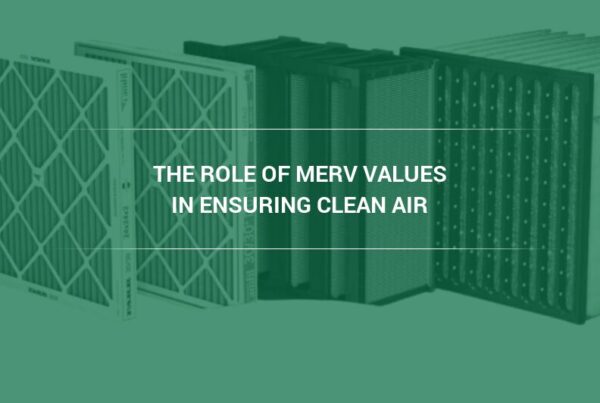The Minimum Efficiency Reporting Value (MERV) tells you the efficiency of an air filter at its lowest performing level. . The American Society of Heating, Refrigerating and Air Conditioning Engineers (ASHRAE), established this rating under Standard 52.2: Method of Testing General Ventilation Air-Cleaning Devices for Removal Efficiency by Particle Size.
Learn more about Camfil Merv 8
http://www.camfil.us/Products/Medium-Efficiency-Panel-Filters/Pleated-Panel-Filters/3030-en-US1/
MERV ratings allow you to make comparisons between filters to determine which is most efficient for your specific application with the goal of eliminating nuisance pollutants in a residence or workplace. In the U.S., the MERV 8 filter has proven to be the most common filter on the market. Why is that? And how can you use MERV ratings to ensure that you buy the most beneficial filter for your needs?
How MERV Ratings Work
Understanding how MERV ratings work can help you understand why MERV 8-rated filters are so popular in the U.S.
ASHRAE created the MERV system 1987 as part of their ongoing process to update their filter testing standard that was initially published in 1968. MERV ratings are based on how well an air filter traps common airborne pollutants within specific size ranges.
According to the National Air Filtration Association, there are 16 MERV values, from 1 to 16, with the tested filter efficiency increasing as the MERV number increases. Filters are tested against 12 size ranges of particles, with the smallest range being around 0.3 micrometers, and the largest range around 10 micrometers. (1)
To put these sizes in perspective, a micrometer – also known as a micron – is one millionth of a meter. A strand of human hair is estimated to be 75 to 100 microns, so some of these particles can only be seen using a microscope.
To determine MERV, an air filter’s performance is determined by measuring the particle counts upstream and downstream of the filter being tested. Particle counts are taken over 12 specific ranges of particle sizes, during six testing intervals, beginning with a clean filter and then after periodic additions of a special ASHRAE test dust for five additional measurement cycles.
Particle density in the test duct is evaluated before and after it passes through the filter. Based upon defined calculations, as noted within the Standard, a specific MERV is assigned to the air filter.
Why MERV 8 Is So Popular
To understand why MERV 8 is so popular in the U.S., you have to know the common contaminants and applications for filters in each MERV group.
According to Mechanical Reps, the MERV rating chart breaks down as follows: (2)
MERV 13 to 16 – effective at controlling airborne bacteria, most tobacco smoke and pollutants released through sneezing. Applicable in general surgery suites, smoking lounges and commercial buildings with superior HVAC systems.
MERV 9 to 12 – effective at controlling humidifier dust, lead dust, vehicle emissions, and welding fumes. Applicable in residences with superior HVAC systems, hospital labs and commercial buildings
MERV 5 to 8 – effective at controlling mold spores, hair spray, dust. Applicable in most commercial buildings, residences, industrial workplaces and paint booths. MERV 8 filters have 90 percent efficiency on particles that are 3 to 10 micrometers in size.
MERV 1 to 4 – effective at controlling larger particles such as, sanding dust, spray paint dust, lint and carpet fibers. Applicable in residences and in window air conditioning units.
The majority of MERV 8 filters are two-inch, pleated filters that have been popular in the U.S. since the 1970s. They are commonly used in American households to eliminate basic pollutants present in most homes and to protect the performance and efficiency of the air-conditioning system.
A MERV 8 air filter is efficient at trapping a majority of indoor particulates that could debilitate those with asthma and allergies, or even cause long-term respiratory problems.
Another factor driving the popularity of MERV 8 filters is that they are inexpensive and easily serviced. Depending on the manufacturer they can last three to six months and even up to a year in residential use.
How To Select An Air Filter
The most important aspect on how to select an air filter for your home or workplace is knowing the quality of your air. So, begin by evaluating the possible components that could affect your air quality to determine pollutants you need to remove. . Select an air filter based upon these pollutants and then follow the manufacturer’s recommendations for changing or servicing the filter.
Remember that MERV 8 filters are medium-efficiency filters that can get rid of most particles, but will have to be changed periodically to maintain performance. Higher efficiency filters that carry a MERV 13 or better are used in commercial buildings but they require HVAC system modification to perform in a residential system.
About Camfil
Camfil is the world leader in air filtration and clean air solutions. For more than 50 years, Camfil has provided filtering devices as part of its commitment to offering clean air solutions in a number of industries.

Lynne Laake
Camfil USA Air Filters
T: 888.599.6620,
E: Lynne.Laake@camfil.com
F: Friend Camfil USA on Facebook
T: Follow Camfil USA on Twitter
Y: Watch Camfil Videos on YouTube
SOURCES



